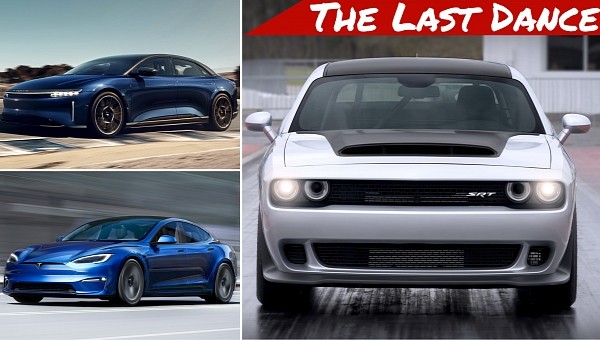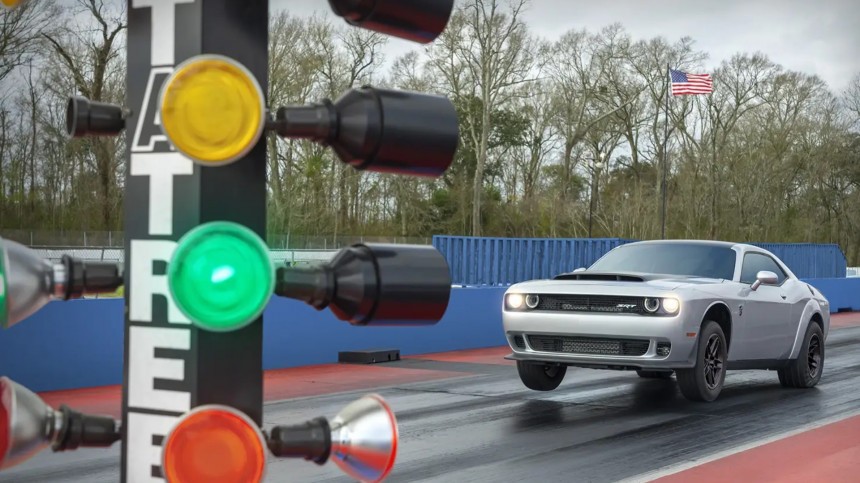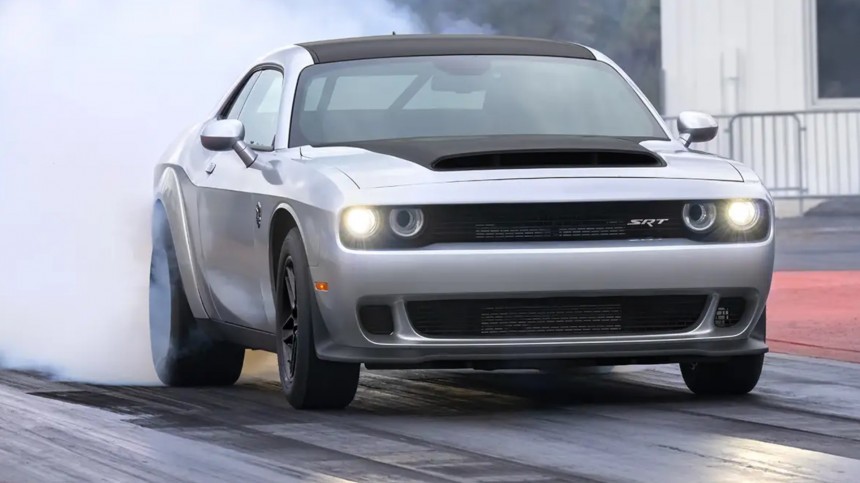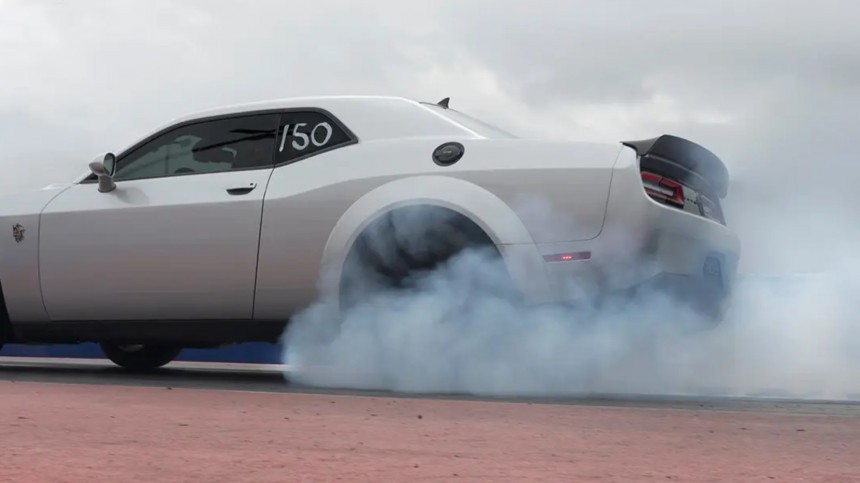Dodge is closing its internal combustion engine muscle car chapter with a bang by revealing what its Challenger Demon 170 is truly capable of. Doing so showed that ICEs can still top the best performance figures of some of the fastest electric vehicles produced, all while costing significantly less. But there is a caveat.
The Dodge Challenger Demon 170 certainly made a statement during its Last Call Vegas Live Reveal. Its exhilarating display of raw, straight-line performance was enough to put EVs on notice, not to mention supercars. Beating the fastest production car quarter-mile time is no easy feat when you're up against some of the fastest stock vehicles in the world. We're talking about cars like the Tesla Model S Plaid and the Lucid Air Sapphire – EVs notorious for making ICEs eat dust in a straight line.
When two of the world's fastest EVs went head to head, the Lucid Air Sapphire managed to best the Tesla Model S Plaid's time by finishing 0.2 seconds faster at a record-setting 9.1 seconds, which was insanely quick as far as factory models are concerned. Keep in mind that by reaching the quarter mile in the low nines, both EVs were still in somewhat uncharted territory. That is, until the Dodge Challenger Demon 170 showed it could do the same in the high eights – 8.9 seconds, to be exact.
What's more impressive is how the 1,075 horsepower rear-wheel drive Demon 170 reached the quarter mile faster than the 1,200 horsepower all-wheel drive Lucid Air Sapphire. Lucid claims the Air Sapphire can go from nothing to 60 mph in under two seconds, but real-world testing showed it did so in 2.1 seconds. Meanwhile, the Dodge Challenger Demon 170's live testing got it an NHRA-certified 0 to 60 mph time of 1.66 seconds.
Aside from claiming to be the first 8-second production car, Dodge also broke records in a category wherein EVs were deemed untouchable. Topping EVs in the quarter mile is an accomplishment in its own right, but Dodge's beastly Demon 170 also beat the acceleration times of some of the most powerful, technologically advanced supercars in the world. The Demon 170's record-shattering attempt outpaced the likes of the 1,500 horsepower Bugatti Chiron Pur Sport – a quad-turbo 8-liter 16-cylinder behemoth that went that distance in 2.3 seconds.
Even the electric-motor-aided Ferrari SF90 Stradale, with all its advanced hybrid features, could only do the feat in two seconds - slower than the all-American 6.2-liter supercharged V8 monster, which is now being compared to million-dollar exotics costing ten times more. In terms of price-performance ratio, EVs are known to be the more practical alternative for those looking to experience supercar levels of acceleration without paying millions of dollars.
However, just because performance EVs like the Lucid Air Sapphire and Tesla Model S Plaid are more affordable than supercars doesn't mean they're cheap. What Lucid dubs the “pinnacle of electric performance” costs as much as its lofty title at $249,000. While the Lucid Air Sapphire's price might make Tesla's fastest offering seem like a bargain at over $109,000, the Dodge Demon 170 makes both EVs appear overpriced, given its starting price of under $100,000.
There's no question that the Last Call Demon is among, if not the greatest American muscle car ever made, but could it also be the greenest? Although the Demon 170 might not overthrow EVs in that regard any time soon, that didn't stop it from trying. In fact, Dodge CEO Tim Kuniskis described it as the first-ever muscle car that's also “eco-friendly” and “sustainable.” That's thanks to its ability to run on ethanol, which emits 45% less carbon than gasoline.
Indeed, that same E85 fuel that gives this mean machine its extra oomph in performance is also what makes it greener, albeit with worse MPGs than your average EV. By being quicker, cheaper, and even a bit greener, Dodge's Mopar icon showed that ICEs can still offer qualities that usually make EVs desirable. Of course, some caveats still surround the Demon 170's extraordinary display of power, as it was done on a prepped surface, which in turn allowed it to reach record-breaking figures.
It would take skill and the right circumstances for other drivers to pull off similar results. Meanwhile, the epic drag race between Lucid and Tesla's top dogs was done on regular asphalt and is more comparable to real-world driving scenarios. Likewise, reaching peak performance would've required less effort in the EVs.
Owners of the previous 2018 Dodge Demon complained about the challenges of gaining traction under normal driving conditions since the constant wheel spin generated from half-throttle made it impractical for daily use. Despite the 2023 Demon 170 featuring improved wheels and tires for better traction, its grip, suspension, and practicality won't likely compare to that of any top EVs. At the end of the day, challenging EVs wasn't exactly the whole point of the SRT Demon's existence, but rather, it was leaving a legacy worth remembering.
With Dodge's inevitable transition to a more sustainable future drawing near, the green-ish Demon serves as a sign of things to come, all while paying homage to a Motown legend at the same time. Sure, streets might fill up with EVs soon, but not without Dodge reminding people what made conventional cars so exciting, using a loud, hellacious vehicle that screams ingenuity as much as crazy.
When two of the world's fastest EVs went head to head, the Lucid Air Sapphire managed to best the Tesla Model S Plaid's time by finishing 0.2 seconds faster at a record-setting 9.1 seconds, which was insanely quick as far as factory models are concerned. Keep in mind that by reaching the quarter mile in the low nines, both EVs were still in somewhat uncharted territory. That is, until the Dodge Challenger Demon 170 showed it could do the same in the high eights – 8.9 seconds, to be exact.
What's more impressive is how the 1,075 horsepower rear-wheel drive Demon 170 reached the quarter mile faster than the 1,200 horsepower all-wheel drive Lucid Air Sapphire. Lucid claims the Air Sapphire can go from nothing to 60 mph in under two seconds, but real-world testing showed it did so in 2.1 seconds. Meanwhile, the Dodge Challenger Demon 170's live testing got it an NHRA-certified 0 to 60 mph time of 1.66 seconds.
Taking high eights before a hiatus
Even the electric-motor-aided Ferrari SF90 Stradale, with all its advanced hybrid features, could only do the feat in two seconds - slower than the all-American 6.2-liter supercharged V8 monster, which is now being compared to million-dollar exotics costing ten times more. In terms of price-performance ratio, EVs are known to be the more practical alternative for those looking to experience supercar levels of acceleration without paying millions of dollars.
However, just because performance EVs like the Lucid Air Sapphire and Tesla Model S Plaid are more affordable than supercars doesn't mean they're cheap. What Lucid dubs the “pinnacle of electric performance” costs as much as its lofty title at $249,000. While the Lucid Air Sapphire's price might make Tesla's fastest offering seem like a bargain at over $109,000, the Dodge Demon 170 makes both EVs appear overpriced, given its starting price of under $100,000.
It's leaner, meaner, and... greener?
Indeed, that same E85 fuel that gives this mean machine its extra oomph in performance is also what makes it greener, albeit with worse MPGs than your average EV. By being quicker, cheaper, and even a bit greener, Dodge's Mopar icon showed that ICEs can still offer qualities that usually make EVs desirable. Of course, some caveats still surround the Demon 170's extraordinary display of power, as it was done on a prepped surface, which in turn allowed it to reach record-breaking figures.
It would take skill and the right circumstances for other drivers to pull off similar results. Meanwhile, the epic drag race between Lucid and Tesla's top dogs was done on regular asphalt and is more comparable to real-world driving scenarios. Likewise, reaching peak performance would've required less effort in the EVs.
With Dodge's inevitable transition to a more sustainable future drawing near, the green-ish Demon serves as a sign of things to come, all while paying homage to a Motown legend at the same time. Sure, streets might fill up with EVs soon, but not without Dodge reminding people what made conventional cars so exciting, using a loud, hellacious vehicle that screams ingenuity as much as crazy.











